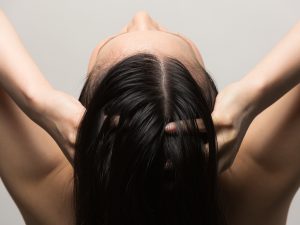Can We Do Anything About Hair Loss?

Hair loss is very common among women; it’s estimated that almost half of us will go through it during our lifetimes. Different factors can contribute to hair loss: hormones and genetics play a role, as do stressors in our lives that we might not even think twice about.
According to New York dermatologist and psychiatrist Amy Wechsler, MD., though the science isn’t perfect yet, there is good research out there concerning hair-loss solutions. The best place to start is by identifying what’s causing the loss in the first place.
Reasons to Hair Loss
Hair loss is genetic and can be passed down in families. However, it’s not as clear how it’s inherited in women as it is in men. Additionally, while men tend to lose hair at the frontal hairline, women instead experience thinning hair overall due to miniaturized follicles.
Not to be left out, hormones play a role in hair growth as well. Estrogen levels have a positive effect on hair growth and can make the growth phase last longer. Pregnant women often experience voluminous hair due to high estrogen levels early on in their pregnancy.
However, toward the end of the third trimester, estrogen levels drop and cortisol—the stress hormone—levels rise; this combination typically leads to postpartum shedding. Women may also encounter hair loss around menopause age when they are more genetically disposed towards it.
Stress, of any kind, can be a formidable underlying cause for hair loss. It could be something psychological like anxiety or grief, or it might be physical stress from surgery or illness.
Hair follicles are delicate and react to both emotional and physical causes of stress. In some cases, it may take up to six months after the initial trigger before hair loss becomes noticeable. If the stressful period is only temporary, usually your hair will start growing back within a few months’ time.
There are many other potential causes of hair loss, such as poor nutrition and an iron deficiency. An overactive or underactive thyroid gland can also be to blame, as well as illnesses like cancer and autoimmune diseases. If you’re worried about hair loss, it’s important to speak with your doctor.

Treatments
What Really Works?
The active ingredient, minoxidil, is helpful. For years, doctors recommended that women use the 5 percent version made for men because it works much better than the 2.5 percent originally created for women; there is a 5 percent version specifically designed for women. Some doctors even compound stronger formulas for patients as needed.
The topical spray for women includes minoxidil, retinol (for improved delivery), melatonin (which has been shown to promote hair growth in the crown area for women), and spironolactone—a medication used to treat acne and unwanted facial hair.
This spray shields the hair follicles from androgens, which are hormones that cause thinning. Spray this or any other hair blend on five to seven times every night, wait three months before seeing signs of change, and be prepared to wait six full months before any real benefits appear.
Harklinikken, a Danish hair clinic with over 25 years of experience in women’s hair loss, offers another approach. A consultation (offered virtually or in person at locations in New York, Beverly Hills, and Tampa) will help you understand whether you’re a candidate for the program that Harklinikken promises will result in a 30 percent improvement in existing hair growth.
The company will create a bespoke extract for you if you’re an eligible candidate, which you’ll use daily. Some of the key ingredients are burdock root, marigold, and proprietary constituents from cow’s milk. It’s about making the concentration high enough and getting those ingredients into a natural fatty acid bubble small enough to enter your follicle.
Though it might not always produce amazing results, this treatment can be helpful, especially when used in combination with other hair treatments.
Also, doctors recommend taking a hair supplement along with vitamin C (vitamin C helps improve iron absorption) to boost overall hair volume. Hair cells are some of the quickest-dividing cells in the body, so optimal nutrition is vital. Zinc and iron appear to be two of the most crucial nutrients for healthy hair growth.

How Often Should We Wash Our Hair?
Although there is no set number of times to wash your hair per week, research has shown that cortisol and dihydrotestosterone—hormones that promote hair thinning—can be found in sebum, which is our natural scalp oil.
For this reason, it’s recommended to wash the scalp at least three times a week. Keep in mind that you don’t always need shampoo to do so—sometimes water will suffice.
Although scalp massage has not been scientifically shown to help preserve hair, it does increase circulation. I appreciate massages because they temporarily lower cortisol levels in the body. If someone is under the impression that vigorously rubbing their scalp for 5–10 minutes each day will cause new hair growth, I’m doubtful of that working.
Does Styling Make a Difference?
The only hairstyle that is known to cause hair loss is very tight braiding, otherwise known as traction alopecia. Any other surface hairstyles may make the hair break, but not fall out. Understandably, then, avoid tight ponytails, overprocessing (for example: chemical straighteners in combination with coloring), and overstyling–particularly with heat styling tools.
Gentle hair brushing is key. Choose a brush that is palm-sized and flexible to create less tension, while its bendy, forgiving bristles minimize snagged hairs.
Some styling tricks can help disguise thinning hair. The best product for you depends on your individual hair type, but in general, it should be light enough to provide texture and soft hold without weighing down your hair. Use a mousse or similar product, then use a round brush to start drying at the roots. Pull up with the brush as you dry your hair to create lift and volume at the root area.
Are There In-Office Options?
Platelet-rich plasma (PRP) treatments for the scalp are similar to other rejuvenation procedures and help stimulate growth factors in the area. Clinical results have shown a significant increase in hair density, thickness, and growth after three to six months of treatment.
The doctors prepare plasma—which is rich in platelets—from a patient’s own blood. They then concentrate it before injecting it directly into the skin on their scalp.
Recent studies show that stem-cell therapy has great potential to help with hair growth. This technique uses bioactive molecules—growth factors, exosomes, cytokines, chemokines, and others—from stem cells to regulate the hair follicle cycle and regenerate hair growth. These molecules are injected directly into the scalp or applied topically by specialists in this field.
Hair transplants have come a long way. The procedure starts by moving hair from one area (usually the back of the head, which is less affected by hormone changes) to another area. It works because it uses more than just the hair shaft—it includes the full anatomy of the hair follicle, which allows newly placed hairs to continue growing in a healthy manner.
The spacing of the transplanted coarse follicles is important; if they are placed too far apart or in a linear design, it will look unnatural. These are signs of a poorly done transplant. To create a natural and healthy frame, the finest hairs must be transplanted at an optimal density.

